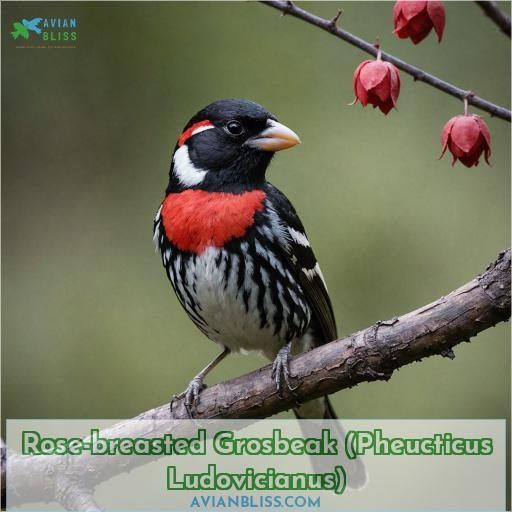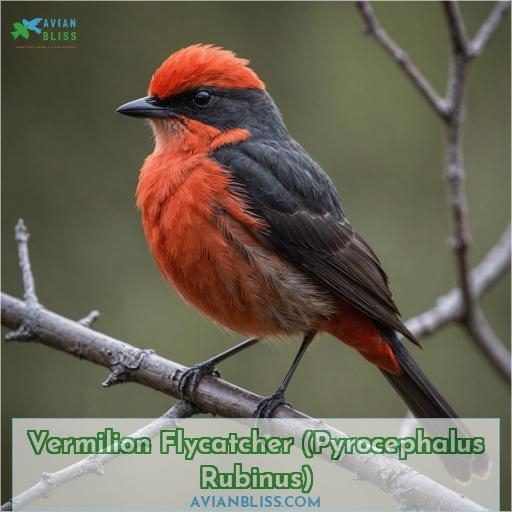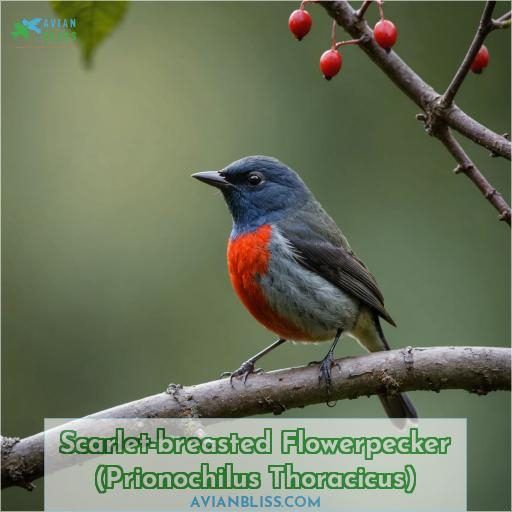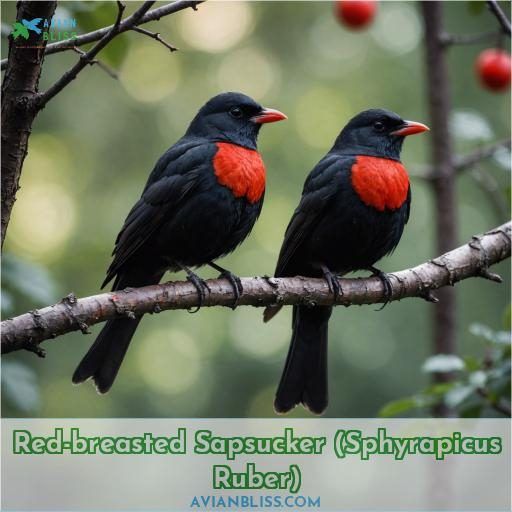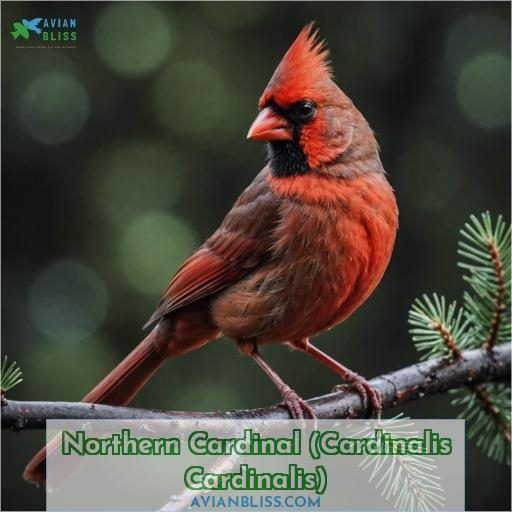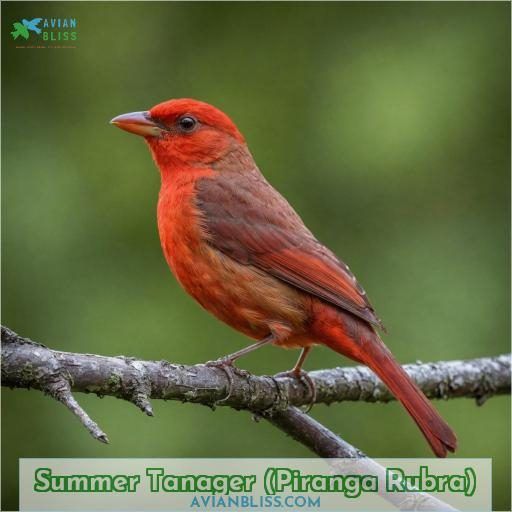This site is supported by our readers. We may earn a commission, at no cost to you, if you purchase through links.
 You’ll be captivated by the striking black birds with red chests that nature has bestowed upon us.
You’ll be captivated by the striking black birds with red chests that nature has bestowed upon us.
The Scarlet Tanager, with its jet-black body and brilliant red breast, is a sight to behold.
The Rose-breasted Grosbeak boasts distinctive black plumage adorned with a vibrant crimson bib.
These radiant avians grace backyards, forests, and open habitats across North America.
While their crimson chests make them unmistakable, explore further to uncover the fascinating stories behind their habitats, behaviors, and the important role they play in ecosystems.
Table Of Contents
- Key Takeaways
- Scarlet Tanager (Piranga Olivacea)
- House Finch (Haemorhous Mexicanus)
- Rose-breasted Grosbeak (Pheucticus Ludovicianus)
- Scarlet Macaw (Ara Macao)
- Red-breasted Meadowlark (Leistes Militaris)
- Vermilion Flycatcher (Pyrocephalus Rubinus)
- Scarlet-breasted Flowerpecker (Prionochilus Thoracicus)
- Red-breasted Sapsucker (Sphyrapicus Ruber)
- Northern Cardinal (Cardinalis Cardinalis)
- Summer Tanager (Piranga Rubra)
- Frequently Asked Questions (FAQs)
- How can I attract black birds with red chests to my yard?
- What is the difference between a Scarlet Tanager and a Summer Tanager?
- Are black birds with red chests aggressive towards other birds?
- How can I tell a male black bird with red chest from a female?
- Do black birds with red chests migrate long distances?
- Conclusion
Key Takeaways
- These birds, including the Scarlet Tanager, Rose-breasted Grosbeak, and Vermilion Flycatcher, are known for their striking black and red plumage that makes them stand out in their habitats.
- Many of these species are found across North and South America, inhabiting forests, woodlands, and open areas, and some are frequent visitors to backyard feeders.
- These birds play important roles in their ecosystems, with their vibrant colors serving purposes like courtship, territorial defense, and species identification.
- Conservation efforts are important to protect the habitats and populations of these charismatic birds, some of which face threats like habitat loss and poaching.
Scarlet Tanager (Piranga Olivacea)
The Scarlet Tanager boasts striking black plumage adorned with vibrant red patches on its body, making it a true avian gem. You’ll find these feathered beauties in deciduous and mixed forests across eastern North America, where their distinctive appearance and hoarse, chuckling calls enliven the woodland scenery.
Distinctive Black and Red Plumage
Scarlet Tanagers boast glossy black plumage contrasted by vibrant red wing epaulets and chest. This distinctive black and red plumage aids in species recognition, making these abundant birds real showstoppers when you spot one.
Habitat and Behavior
You’ll find the scarlet tanager in deciduous and mixed forests during breeding season. These sociable birds forage for insects and fruits, nesting in tree cavities. Their loud vocalizations, brilliant red body with black wings and back, make them stand out amidst greenery.
Identification Tips
The scarlet tanager‘s bold black, white, and rose-red plumage, along with its distinctive face pattern and large bill, make it easy to identify. Its sweet whistles and sharp chink calls also help distinguish it from similar species like the summer tanager.
Migration and Distribution
The Scarlet Tanager’s migration patterns take it from its breeding grounds in eastern North America to its wintering sites in Central and South America. Its vibrant plumage and distinctive calls make it a delight to spot during spring and fall migrations.
Backyard Attracting
Attract the vibrant Scarlet Tanager to your backyard by offering a variety of seeds:
- Fill feeders with sunflower seeds, safflower seeds, and raw peanuts to entice this striking bird.
- Provide a diverse backyard habitat to welcome this feathered gem.
- Enjoy the Scarlet Tanager’s mesmerizing presence and melodious songs in your outdoor oasis.
House Finch (Haemorhous Mexicanus)
The male House Finch sports a vibrant red face and breast that can catch any birdwatcher’s eye, complementing its brown-streaked body and blunt, seed-crunching beak. Keep an eye out for these backyard visitors at your feeders and listen for their cheerful, warbling songs echoing through neighborhoods across North America.
Physical Description
The House Finch boasts a vibrant crimson-red chest and face, contrasting with its brown-streaked back and wings.
Females sport a mottled brown plumage, lacking the male’s fiery hues.
During the breeding season, the male’s size and bold field marks make him hard to miss, with his black legs and feet standing out against the lush greenery.
This feathered gem is a true delight to behold.
Identification
The female House Finch’s mottled brown plumage and juvenile-like appearance can make identification tricky. However, a few key features stand out:
- Prominent pale eyebrow stripe
- Pink to buffy throat
- Heavily streaked breasts and bellies
These subtle details, combined with the bird’s preference for forest edges and woodlands, will help you confidently identify this red-chested beauty.
Backyard Tips
Attract House Finches to your backyard with their vibrant red heads and breasts. Fill your feeders with their favorite sunflower and safflower seeds. Position the feeders near shrubs or trees where they can perch and survey their domain. With a little patience, you’ll soon have these stunning songbirds gracing your outdoor space.
Rose-breasted Grosbeak (Pheucticus Ludovicianus)
The Rose-breasted Grosbeak is a bold black bird with a stunning red patch on its breast and white markings on its wings. You can identify this songbird by its large seed-eating beak, loud robin-like song, and frequent presence at backyard feeders stocked with sunflower seeds.
Identification & Behavior
The Rose-breasted Grosbeak’s distinctive black, white, and red plumage makes it easy to identify. Females are more mottled brown, but both sexes have a large, powerful bill. During breeding season, males flaunt their vibrant wing epaulets to attract mates in forest edge habitats.
Habitat and Range
The rose-breasted grosbeak thrives in the lush deciduous forests and woodland edges of eastern North America. Its breeding grounds stretch from Canada to the Appalachian Mountains, and its winter range extends as far south as Panama. This vibrant songbird’s habitat is as diverse as its plumage.
Nesting and Breeding
When breeding, Rose-breasted Grosbeaks build nests high in trees, laying 3-5 eggs. Both parents defend the territory and feed the chicks. Their striking black, white, and red plumage helps attract mates during this critical breeding season.
| Nest Building | Egg Laying | Chick Feeding |
|---|---|---|
| Constructed high in trees | 3-5 eggs laid | Both parents feed young |
| Sturdy cup-shaped nest | Incubated for ~14 days | Chicks fledge in 10-12 days |
Migration Patterns
The rose-breasted grosbeak’s migration patterns take it on an impressive journey each year. These striking black and red birds travel between their breeding ranges in North America and wintering grounds in Central and South America, stopping at key habitats along the way.
Attracting to Backyard
Attract rose-breasted grosbeaks to your backyard by offering their favorite sunflower and safflower seeds in red bird feeders. Incorporate native plants that provide cover and nesting sites. Observe their lively courtship displays and protect them from predators.
Scarlet Macaw (Ara Macao)
The Scarlet Macaw (Ara macao) is a striking, vividly colored parrot with vibrant red, blue and yellow plumage. You’ll find this iconic bird inhabiting the tropical rainforests of Mexico, Central and South America, where its powerful curved beak helps it feed on nuts, seeds, fruits and vegetation.
Physical Characteristics
The Scarlet Macaw boasts a striking appearance, with vibrant red, blue, and yellow feathers covering its body. Its large, hooked beak and strong talons make it a formidable bird. The macaw’s sexual dimorphism isn’t pronounced, with males and females appearing similar.
Habitat and Diet
The Scarlet Macaw thrives in the lush rainforests of Central and South America, foraging on a diverse diet of fruits, nuts, and seeds. Their vibrant plumage blends seamlessly into the verdant canopy as they nest high above the forest floor.
| Habitat | Diet | Conservation |
|---|---|---|
| Tropical rainforests | Fruits, nuts, seeds | Threatened by habitat loss and poaching |
Behavior and Vocalizations
The Scarlet Macaw’s vibrant plumage isn’t just for show – it plays a vital role in their lively courtship rituals and territorial behavior. Their loud, raucous calls echo through the forest, serving as mating calls and to defend their nests.
Conservation Status
The Scarlet Macaw’s conservation status is classified as Least Concern, but habitat loss and poaching threaten its populations. Conservation efforts focus on protecting forests, regulating trade, and promoting sustainable practices to safeguard this vibrant species for the future.
Captive Care and Breeding
Caring for scarlet macaws in captivity demands specialized breeding methods, a customized captive environment, a nutritious diet, and attentive health monitoring. Provide adequate space, enhance their habitat, and fulfill their dietary requirements to guarantee their well-being and successful breeding.
Red-breasted Meadowlark (Leistes Militaris)
The Red-breasted Meadowlark, a South American blackbird, inhabits open and semi-open habitats along rivers and agricultural lands. It holds an uncommon and localized status.
You’ll find this species, formerly known as Sturnella militaris, across Amazonia, Colombia, Ecuador, Brazil, and Bolivia. Its Spanish moniker Pecho Colorado Grande and scientific name Leistes militaris (the robber or plunderer) hint at its bold, martial appearance.
Habitat and Status
The Red-breasted Meadowlark is found in parts of South America, including Colombia, Ecuador, Brazil, and Bolivia. This uncommon and local species prefers open and semi-open habitats along rivers and agricultural lands. Its conservation status is Least Concern, though habitat loss remains a concern in some regions.
Name & Etymology
The Red-breasted Meadowlark’s scientific name, Leistes militaris, provides a glimpse into its origins. Leistes means robber or plunderer, while militaris refers to its military or martial appearance. This evocative name captures the bird’s bold, striking plumage and its assertive presence in its South American habitats.
Distribution
The Red-breasted Meadowlark’s breeding range spans from Costa Rica down through Peru and Bolivia, as well as parts of Brazil, the Guianas, and Trinidad. During the non-breeding season, they can be found further east in Brazil. Though uncommon and local, their geographical distribution covers a wide swath of northern South America.
- Breeding range extends from Central to South America
- Winters in eastern Brazil and surrounding regions
- Migratory patterns involve seasonal movements within range
- Listed as Least Concern by IUCN due to stable population
Similar Species
The Red-breasted Meadowlark may be confused with the similar-looking White-browed Blackbird, but the male Red-breasted lacks the distinctive white eyebrow stripe. Females of the two species are nearly identical, but the Red-breasted has a longer bill, smaller size, and more red on the underparts.
| Trait | Red-breasted Meadowlark | White-browed Blackbird |
|---|---|---|
| Male Plumage | Black with red throat, breast, shoulders | Black with white eyebrow stripe |
| Female Plumage | Mottled brown, pale superciliary | Mottled brown, similar to female Red-breasted |
| Size | Smaller | Larger |
Vermilion Flycatcher (Pyrocephalus Rubinus)
The Vermilion Flycatcher is a striking bird, the male boasting a bright scarlet crown, breast, and underparts that contrast boldly against its dark brown wings and back. You’ll often find these eye-catching flycatchers nesting in cavities, with the males performing aerial displays and calling loudly to defend their territory during breeding season.
Description
You’re about to encounter a striking bird that will leave you in awe. Picture a male Vermilion Flycatcher – sleek black plumage contrasted by a ruby-red crown and underparts that seem to glow under the sun. Here are a few fascinating facts:
- Females sport a duller brown plumage during the breeding season
- Males have distinct black legs and dark brown bills
- Larger males tend to be more successful in attracting mates
This vivid splash of color is a sight to behold, especially when the males perform aerial displays to woo potential partners. Brace yourself for an unforgettable encounter with nature’s feathered jewels!
Breeding and Nesting
During the breeding season, the vibrant Vermilion Flycatcher pairs up to construct their nest.
The female takes the lead, carefully weaving a cup-shaped structure using fine grasses, plant fibers, and animal hair. She thoughtfully selects a sheltered spot, often in the fork of a tree or shrub, to protect her precious cargo.
Once the nest is complete, the female lays 2-4 eggs and attentively incubates them for around 14 days.
Both parents share the responsibility of feeding the hatchlings, ensuring their survival. As the chicks grow, the dedicated pair continues to provide diligent brood care until the young fledglings are ready to take flight and explore the vibrant world on their own.
Scarlet-breasted Flowerpecker (Prionochilus Thoracicus)
The scarlet-breasted flowerpecker, a delightful addition to Southeast Asia’s avian landscape, inhabits evergreen forests and forest edges from Myanmar to the Philippines. Measuring around 10 cm long, this tiny bird boasts striking black and crimson plumage, foraging for nectar and insects while expertly maneuvering through dense foliage.
Habitat and Distribution
The Red-breasted Meadowlark is found in open and semi-open habitats along rivers and agricultural lands across Amazonia, Colombia, Ecuador, Brazil, and Bolivia. Its distribution is localized, and it’s considered an uncommon species. Conservation efforts aim to protect its shrinking natural environments. Similar species include the White-browed Blackbird.
Behavior and Diet
The scarlet-breasted flowerpecker is a lively little bird that flits through the forest canopy, darting from flower to flower in search of nectar. Its vibrant plumage and nimble movements captivate onlookers. This bird:
- Forages for nectar, pollen, and small insects
- Prefers dense, humid forests and woodlands
- Travels in small, active flocks
- Vocalizes with high-pitched, twittering calls
Breeding Biology
Imagine the scarlet-breasted flowerpecker’s mating ritual: vibrant males perform aerial displays to attract females during breeding season. Once paired, they carefully construct intricate, hanging nests. Inside these woven pouches, the female incubates her brightly speckled eggs, awaiting the arrival of new fledglings.
| Aerial Courtship | Careful Nest Building | Vibrant Hatchlings |
|---|---|---|
| Dazzling males soar, flapping ruby wings to impress potential mates. | Intricately woven globular nests dangle from branches. | Downy chicks emerge, beaks agape, awaiting insect morsels. |
Conservation Concerns
The Scarlet-breasted Flowerpecker faces concerning conservation challenges. Habitat loss due to deforestation and urbanization threatens its survival. Population declines have been observed, with the species now classified as Near Threatened. Recovery efforts must address these threats to protect this vibrant feathered gem.
- Habitat loss from deforestation and urbanization
- Declining population trends and Near Threatened status
- Urgent need for targeted conservation actions
Red-breasted Sapsucker (Sphyrapicus Ruber)
You’ll be captivated by the Red-breasted Sapsucker’s striking black, white, and red plumage, with males boasting a vibrant red head, breast, and rump. These woodpeckers expertly drill neat rows of sap wells in tree trunks and consume the nutritious sap, insects caught in the sticky flow, and any soft inner bark.
Physical Traits
The Red-breasted Sapsucker boasts a striking appearance, with its glossy black plumage accented by vibrant red epaulets and a buffy throat. Its streaked breasts and pale eyebrow stripe add to its distinctive look, making it a true gem among the avian world.
Habitat and Foraging
The Red-breasted Sapsucker thrives in the lush, coniferous forests of western North America. This industrious woodpecker forages by methodically flaking bark off dead trees, hunting for tasty insect larvae. Its diverse diet also includes:
- Sap from freshly drilled wells
- Fruits and nuts
- Spiders and other small prey
- Insects gleaned from tree bark
Nesting and Reproduction
You’ll witness the red-breasted sapsucker’s nesting period when they excavate cavity nests, often reusing old ones. The female lays 4-7 eggs and incubates for 12-13 days. Both parents feed the nestlings, with brood sizes averaging 4-5 chicks. Their attentive parental care guarantees nestling survival.
Relationship With Humans
The red-winged blackbird‘s striking black and red plumage makes it a favorite among birdwatchers. During breeding season, these bold birds are a common sight in marshes and fields. Attract them to your backyard with feeders stocked with their favorite seeds and suet. Their vibrant colors are sure to delight nature lovers.
Northern Cardinal (Cardinalis Cardinalis)
You’re sure to be captivated by the Northern Cardinal’s striking appearance – a vibrant red body, black face mask, and bright orange beak make it nearly unmistakable. Listen closely and you’ll hear the male’s distinctive cheer, cheer, cheer call ringing out, a cheerful song that often attracts these beloved birds to backyard feeders and birdbaths.
Distinctive Appearance
The Northern Cardinal is one of North America’s most distinctive birds, with its vibrant red plumage, black face mask, and striking red beak.
Males are particularly conspicuous, with their glossy black bodies and flashy red field marks.
Females, on the other hand, are more subdued in their mottled brown and buff tones, but no less charming.
The size difference between the sexes is also quite pronounced, with males being considerably larger than their female counterparts.
These physical variations make the Northern Cardinal a true standout, especially during the breeding season when their bold colors are on full display.
Vocalizations
The Northern Cardinal’s vocalizations are a true delight. Its cheerful, whistled songs fill the air, especially during the breeding season when males use them for mating displays and to mark their territory. These acoustic communications also play a role in interspecific interactions, helping cardinals assert dominance and defend resources. Their versatile voices are a hallmark of these vibrant feathered gems.
Backyard Attraction
The Northern Cardinal is a backyard gem that will liven up your outdoor space. Attract these vibrant birds by stocking your feeders with their favorite treats – sunflower seeds, safflower seeds, and raw peanuts. You’ll delight in their cheerful songs and bright red plumage as they become regular backyard visitors. Get ready to enjoy nature’s feathered masterpieces up close!
Summer Tanager (Piranga Rubra)
The Summer Tanager is a true showstopper, with its vibrant red plumage that seems to radiate warmth. Unlike its cousin the Scarlet Tanager, this bird sports an all-over crimson hue, making it a sight to behold. During the breeding season, the males belt out a distinctive song, a series of rich, burry whistles that echo through the forests. Come fall, these beauties commence a long journey, traveling from the southeastern U.S. down to Central and South America. Keep an eye out for their fiery flash as they flit through the treetops!
| Breeding Habits | Song Patterns | Migration Routes |
|---|---|---|
| Nest in mature forests and woodlands | Rich, burry whistles | Southeastern U.S. to Central/South America |
| Females build cup-shaped nests | Distinctive vocalizations | Long-distance travelers |
Frequently Asked Questions (FAQs)
How can I attract black birds with red chests to my yard?
To attract vibrant red-breasted blackbirds, set up feeders with sunflower seeds and scatter millet on the ground. For example, a family hung mesh socks filled with seed mixes, drawing in dozens of these striking birds to their backyard oasis.
What is the difference between a Scarlet Tanager and a Summer Tanager?
You’ll spot the Scarlet Tanager’s jet-black wings contrasted against its vivid red body, while the Summer Tanager sports an entirely rich red plumage. The Scarlet’s larger size and thicker bill also distinguish the two species.
Are black birds with red chests aggressive towards other birds?
Indeed, male blackbirds with vibrant red chests can be quite territorial and aggressive, particularly during breeding season. They’ll fiercely defend their nests and territories from rivals and potential threats. However, their feisty nature adds to their charm and appeal as spirited backyard visitors.
How can I tell a male black bird with red chest from a female?
To distinguish males, look for glossy black bodies, vivid red patches on their shoulders or chest, and larger sizes. Females are drab brown with streaked patterns – no bold red markings. Size and coloration are your key visual cues.
Do black birds with red chests migrate long distances?
As the old saying goes, Birds of a feather flock together. Yes, many black birds with red chests, like the Red-winged Blackbird, migrate long distances to find suitable breeding and wintering grounds. Their annual journeys can span hundreds of miles across North America.
Conclusion
Whether serenading from backyard boughs or gracing sprawling woodlands, these black birds with red chests captivate with their striking plumage. From the Scarlet Tanager’s fiery breast to the Rose-breasted Grosbeak’s crimson bib, their radiance ignites a sense of wonder. Embrace nature’s vibrant feathered gems; their presence enriches our landscapes and reminds us of the beauty thriving in our midst.



